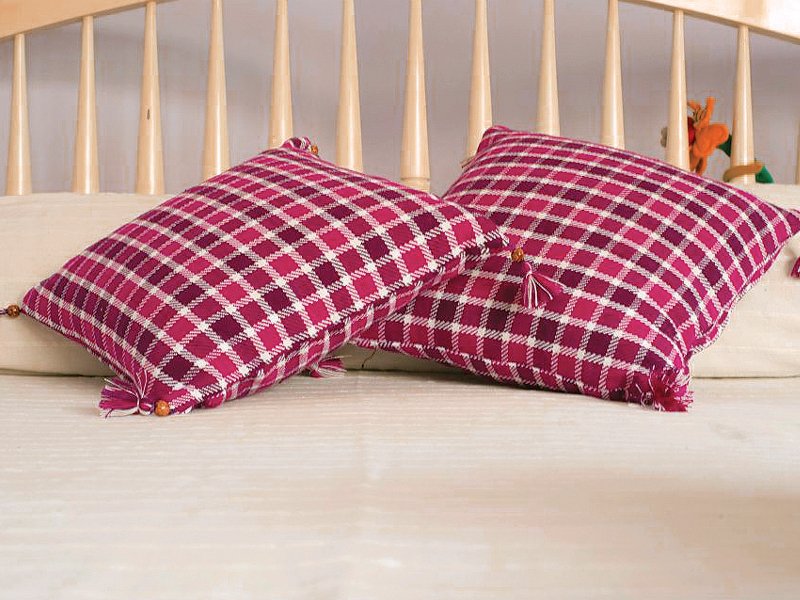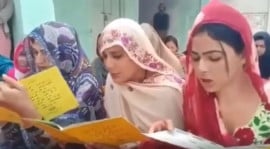
Ansari is a member of the Daachi Foundation, a non-profit organisation set up to revive and promote the arts and crafts of Pakistan. When the foundation was established, each committee member had to adopt a craft, which they were then responsible for revitalising, protecting and monetising. Ansari picked the khais. “I simply felt that the khais of Kasur was a totally neglected lot,” she says.
Khais, a form of light blanket, was created during the Mughal era to meet the demand for cotton blankets. It was woven by hand in village households and would take days to create. One blanket consists of four parts which are later woven together to make a chockra, the size of a bedsheet. The most popular colours are deep yellow, red, black, blue and green (white being regarded as neutral).

Ansari had believed that the khais has potential only if marketed properly. But when she went looking for khais artisans in Kasur, she found only one. The elderly man was the only one weaving by hand. His sons preferred to work on machines and refused to learn the craft from their father. This virtually spelled the end for khais-making.
Ansari spent almost a year researching the weavers of Kasur to discover what was going wrong. “[The craft] needed new design[s], a new direction. Most importantly, it needed to be marketed the right way,” she says. So, the first thing she did was change the colour palette altogether. The weavers were using a traditional combination of bright colours with the same old designs and there was no variety.
Ansari’s plan had three phases, the first involved getting the artisans to weave khais in thematic shades for winter, summer, autumn and spring collections. Working closely with the artisan, Ansari would first choose the colours and then they would both experiment with different designs and combinations. The idea was to encourage the weaver learn new designs and techniques.
When Ansari had a chockra made in a certain colour scheme for the final collection, she realised that it could also be used in a variety of other products. She went out and bought lap trays, tea cloths, napkins, cosmetic bags and cushion covers and showed them to the artisans. This helped them think beyond the blanket in to entirely different product lines.
She also realised that she could involve other artisans in the different stages of making these products. “I showed my own lap tray to a carpenter and trained him to make more like these while using the khais as a cover of the bean bag at the back.” The carpenter was happy to learn and it soon proved to be a side-business for him since it did not take too much of his time. Similarly a tailor was shown how to stitch the small cosmetic bags out of the khais provided by the artisans.
Marketing was a challenge. The only promotion that the artisans got was from peddling their wares on bicycles. They would roam around the streets of nearby cities, shouting out to customers, trying to strike a bargain. Ansari helped them jazz up their packaging by putting the finished product in cellophane lined with colourful jute thread tassels.
The artisans were pushed to display their work at the Daachi Mela. “The products sold like hot cakes,” says Ansari. “They were picked up by craft lovers and people who were interested in keeping this ancient tradition alive.”
The success was encouraging and all those involved in the project, the carpenter, the tailor and the weaver felt a sense of accomplishment. “By making these mats, runners and tea cosies I have realised how interesting it is to try new ideas and how I can implement them in my everyday work,” says Shahbaz who works in upholstery, quilting and drapery. “Things that we thought were useless are being used in an innovative way.” This extra work has made it possible to save for a UPS that will help him continue work during power outages.
Even for carpenter Mohammad Bashir, who has been making furniture for 40 years, the work has been fruitful. “For me, it is like a side business and boosts my household budget,” he says. “And I thoroughly enjoyed using different materials to make a small useful product like a lap tray.” He enjoys working with the team and often gives Ansari ideas on how they can improve their sales, evidence that the project not only stimulates old artisans but also educates those who work with them.
Cushion: Rs1,000
Teacosy: Rs800
Handbag: Out of stock
Runner: Rs1,600
Toiletries Bag: Rs1,600 (set of 2)
AVAILABLE WITH IRAM ANSARI 0333-4245834
Published in The Express Tribune, Sunday Magazine, June 23rd, 2013.
Like Express Tribune Magazine on Facebook, follow @ETribuneMag on Twitter to stay informed and join the conversation.
COMMENTS (4)
Comments are moderated and generally will be posted if they are on-topic and not abusive.
For more information, please see our Comments FAQ



1725885571-0/Tribune-Pic-(9)1725885571-0-165x106.webp)













please do business with india as welll this craft is lovely ...india has alot of diversity it always have welcomed it ..as it the seed of the constitution of the country and hence we must welcome an economic corridor lets share our diversity ....lets welcome it rather pakistan's pathetic unsocial scientific one unit policy
@Mughees: "it seems quite impossible that a new generation of products can be introduced in the market" Mughees ! when young - new generation decides to introduce, that means they have the idea and WILL. So if they have had an idea, then everything is possible. Hold your head high boy, and fight back with your creation for betterment of lives of other. that is real HUMANITY. ask boys and girls at ET to enlist your emails, so anyone interested, could contact you. you be sure they help. Bless you ad all those with you.
Its great to know somebody is working on an idea. Making shawls and khais is my family business for over 40 years. We have cautiously made very small innovations over time and it seems quite impossible that a new generation of products can be introduced in the market. All the designs and artisans for Kasur are from Multan and Kasur itself has skilled workers.
miss Haque ! would you very kindly enlist here email address of Miss Ansari? Thank you.